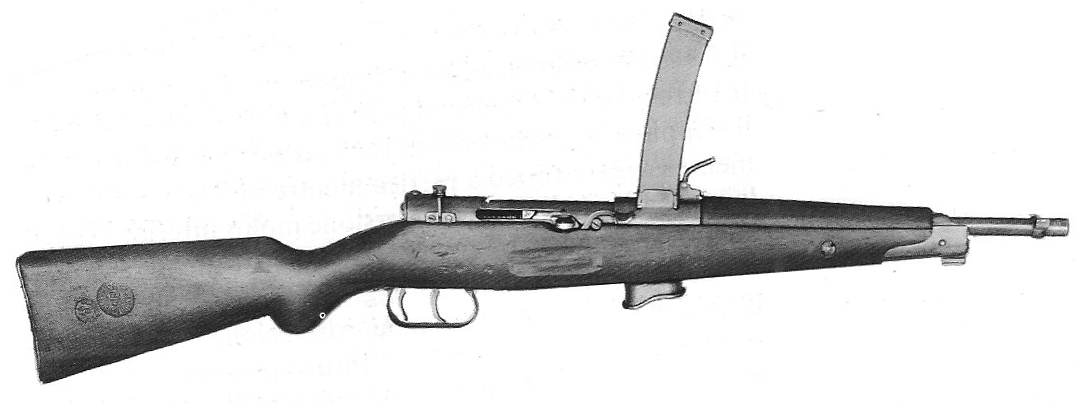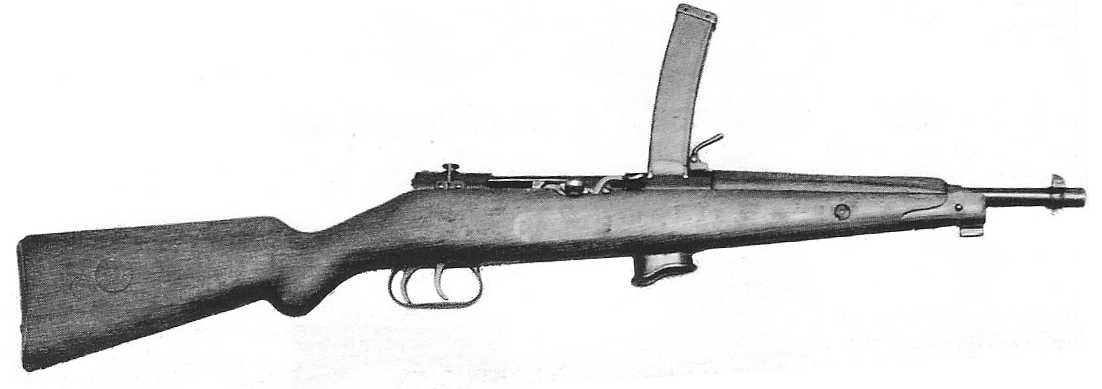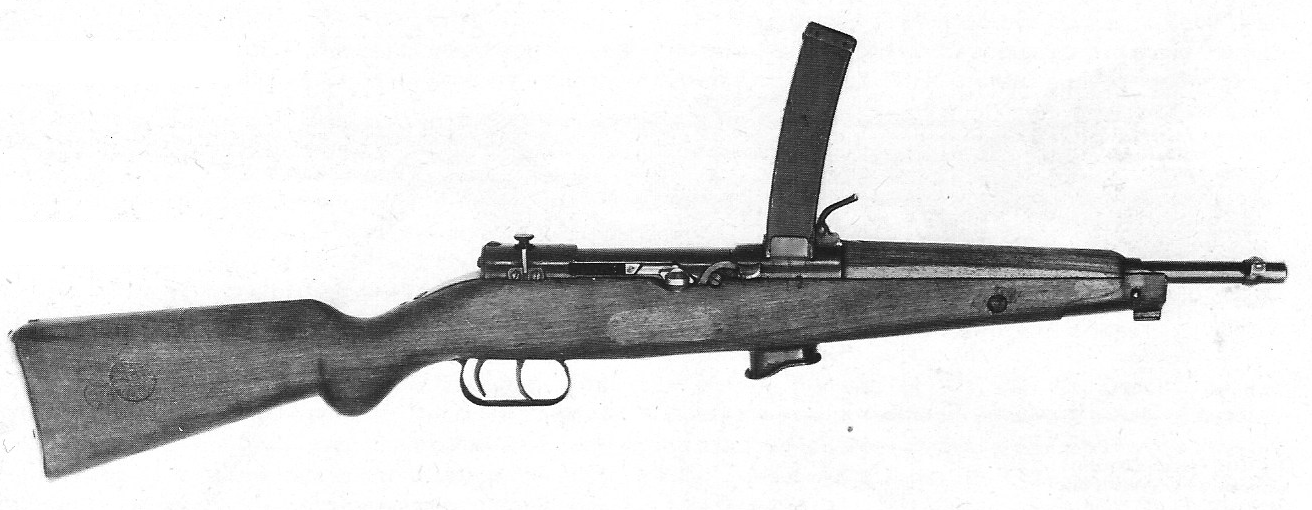MIDA Savoia submachine gun
[IT]
Moschetto Automatico Savoia

(Photo: Beretta Museum)
From the middle of 1917, a submachine
gun concept began to take form in Italy which was known as the 'Moschetto Automatico'. This was
essentially based around the principle of adapting the twin-barreled Villar Perosa
submachine gun - in service with the Italian Army since 1915 as a
mounted machine gun - into a single-barreled infantry carbine fired
from the shoulder. The first such efforts to develop a weapon along
these lines had already been undertaken by the Aviation Corps in
December 1916, but the terrestrial army was not initially receptive to
the idea and it took some time for it to gain acceptance as a serious
concept. It was really through the intervention of Arditi
officers on the front, who desired a true submachine gun for
trench assaults, that the Moschetto
Automatico became a service weapon.
The first two Moschetti Automatici that are known to have been developed (exempting the Carabinetta O.V.P. which was designed for the Aviation Corps) were the Cei-Rigotti and Revelli-Beretta designs, which appeared around September 1917. Later, by the spring and summer of 1918, several other parties became involved in the conception of moschetto prototypes, including Fiat, Ansaldo, Neri, Troiano, Mega, and the Tappari brothers. One of the participating companies was the aviation firm Società Idrovolanti Alta Italia, known as SIAI Savoia, who delegated work on the prototypes to Manifattura Italiana d'Armi (MIDA) in Brescia. Work on this gun was overseen by MIDA director Alfredo Scotti, who was a prolific arms designer in his own right.
The Savoia submachine gun was essentially similar in design to the Revelli-Beretta, though it exhibited some differences. The most notable was the inclusion of a twin trigger arrangement that gave automatic fire from the rear trigger and single shots from the forward trigger; in fact, this may well have been one of the very first automatic weapons to employ a double trigger group, and it no doubt influenced the inclusion of the same feature on the later Beretta submachine guns. A single Villar Perosa receiver formed the main body of the gun and the cocking pawl, which raised the bolt out of the locking cam, was retained. The Savoia submachine gun also used a full-length stock, patterned after that of the Carcano 'Truppe Speciali' carbine, which took a detachable Mod. 91 sword bayonet, as opposed to the Beretta design which had a half-length cavalry style stock with an integral folding spike bayonet. The sights of the Savoia submachine gun were mounted on the right side and the magazine release catch was the standard spring-release type seen on the later pattern Villar Perosa (i.e. those produced from about 1917 onward).
300 Moschetti Automatici Savoia prototypes had been completed by July 1918 and were subjected to trials by the ordnance department. These guns gave a good performance on a technical level but the fire rate was considered to be excessive and difficult to control. The Army expressed a desire for a semi-automatic weapon (which would be fulfilled in the form of the Revelli-Beretta) and requested that some measures be taken to either reduce the rate of fire or otherwise remove the fully-automatic function entirely. For further evaluation, 10 Savoia submachine guns were distributed to the Arditi for field trials in September 1918, whereas the remaining 290 guns were sent to Brescia Arsenal where they were to be recycled into Revelli-Beretta carbines.
The Moschetto Automatico Savoia was ultimately not accepted into service and was beaten out by the Revelli-Beretta submission, which was officially adopted by the Italian Army in September 1918. Afterwards, all work on the Savoia design ceased and MIDA was subcontracted to assist with production of the Revelli-Beretta. Nevertheless the Army retained some Savoia prototypes for use as test controls during the later Moschetto Automatico per Fanteria trials in the early 1920s, which were intended to replace submachine guns with automatic carbines chambered in intermediate rifle calibres.
The first two Moschetti Automatici that are known to have been developed (exempting the Carabinetta O.V.P. which was designed for the Aviation Corps) were the Cei-Rigotti and Revelli-Beretta designs, which appeared around September 1917. Later, by the spring and summer of 1918, several other parties became involved in the conception of moschetto prototypes, including Fiat, Ansaldo, Neri, Troiano, Mega, and the Tappari brothers. One of the participating companies was the aviation firm Società Idrovolanti Alta Italia, known as SIAI Savoia, who delegated work on the prototypes to Manifattura Italiana d'Armi (MIDA) in Brescia. Work on this gun was overseen by MIDA director Alfredo Scotti, who was a prolific arms designer in his own right.
The Savoia submachine gun was essentially similar in design to the Revelli-Beretta, though it exhibited some differences. The most notable was the inclusion of a twin trigger arrangement that gave automatic fire from the rear trigger and single shots from the forward trigger; in fact, this may well have been one of the very first automatic weapons to employ a double trigger group, and it no doubt influenced the inclusion of the same feature on the later Beretta submachine guns. A single Villar Perosa receiver formed the main body of the gun and the cocking pawl, which raised the bolt out of the locking cam, was retained. The Savoia submachine gun also used a full-length stock, patterned after that of the Carcano 'Truppe Speciali' carbine, which took a detachable Mod. 91 sword bayonet, as opposed to the Beretta design which had a half-length cavalry style stock with an integral folding spike bayonet. The sights of the Savoia submachine gun were mounted on the right side and the magazine release catch was the standard spring-release type seen on the later pattern Villar Perosa (i.e. those produced from about 1917 onward).
300 Moschetti Automatici Savoia prototypes had been completed by July 1918 and were subjected to trials by the ordnance department. These guns gave a good performance on a technical level but the fire rate was considered to be excessive and difficult to control. The Army expressed a desire for a semi-automatic weapon (which would be fulfilled in the form of the Revelli-Beretta) and requested that some measures be taken to either reduce the rate of fire or otherwise remove the fully-automatic function entirely. For further evaluation, 10 Savoia submachine guns were distributed to the Arditi for field trials in September 1918, whereas the remaining 290 guns were sent to Brescia Arsenal where they were to be recycled into Revelli-Beretta carbines.
The Moschetto Automatico Savoia was ultimately not accepted into service and was beaten out by the Revelli-Beretta submission, which was officially adopted by the Italian Army in September 1918. Afterwards, all work on the Savoia design ceased and MIDA was subcontracted to assist with production of the Revelli-Beretta. Nevertheless the Army retained some Savoia prototypes for use as test controls during the later Moschetto Automatico per Fanteria trials in the early 1920s, which were intended to replace submachine guns with automatic carbines chambered in intermediate rifle calibres.
Known surviving models:
| Collection | Location | Notes | Condition |
| Museo Internazionale Armi Leggere
Terni |
Terni, Italy |
Various
models |
Appears
good |
| Beretta Private Museum | Gardone
Val Trompia, Italy |
One
gun |
Very
good |
| Private ownership | Italy | Full-auto trigger removed | Very good |
Resources used:
- Vittorio Balzi, I
Mitra Italiani 1915 - 1991 (Florence: Editoriale Olimpia,
1992)
- Filippo Cappellano, 'La Genesi
del Moschetto Automatico Italiano', Storia
Militare, No. 194 (November 2009)

